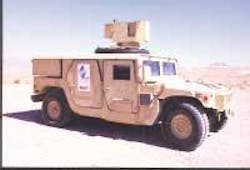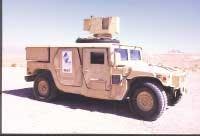Army develops laser to destroy surface land mines
by John McHale
HUNTSVILLE, Ala. — Engineers at the U.S. Army Space and Missile Command (SMDC) in Huntsville, Ala., and Sparta in La Jolla, Calif., are developing a laser-based system called Zeus to neutralize surface-laid landmines or unexploded ordnance remotely.
Zeus uses its laser beam to heat the target until the ordnance explodes in a controlled way; the system does not depend on the type of fusing. The result is a low-order explosion that minimizes collateral damage, says Owen Hofer, Sparta program manager for Zeus.
In wartime, Zeus would be useful to neutralize air-dropped, artillery-launched, or surface-laid landmines from occupied areas, main supply routes, bridges, aircraft runways, and taxiways. In peacetime, it could neutralize booby-trapped mines or cut trip wires from mines.
It also can clear unexploded ordnance, or tell if a mine is a dud, says Scott McPheeters, program manager for Advanced Systems at the SMDC. Zeus is not effective against buried mines.
To date experts have tested laser neutralization against anti-tank mines, anti-personnel mines, rifle grenades, artillery rounds, and general-purpose bombs, Sparta officials say.
The range of the system is from 25 to 250 meters, as long as the target is in the line of sight, Hofer says. The long range also increases safety with more dangerous ordnance, he adds. Other safety features include laser safety interlocks, laser safety glass on all windows, and air conditioning for cooling personnel and electronic equipment.
Zeus's high-power laser, beam director, operator's station, and all support subsystems are self-contained on an unarmored HMMWV, Sparta officials say. Zeus uses commercial-off-the-shelf components, but is a custom system design, Hofer says.
The simple-to-operate laser neutralization hardware has a visible-light color camera for scene display and a joystick for target scene scanning and laser pointing, Hofer says. The invisible high-power laser is co-boresighted with a visible green doubled designator laser.
The operator uses the joystick to slew the camera to perform surveillance of the scene using the camera's 28-to-1 variable zoom lens as necessary. Once operators detect a target visually, they slew the green designation laser onto the target and select an aimpoint. The high-power laser then takes over to neutralize the mine.
It is much like playing a video game, which is why the younger generation of soldiers is very adept at operating this type of system; they grew up playing electronic games just like it, Hofer says.
The ZEUS system uses a 1-kilowatt diode-pumped laser for neutralizing the ordnance, which is low power as far as the Army is concerned, McPheeters says. Options include forward-looking infrared cameras, fiber-optics for engaging non line-of-sight targets, and a Global Positioning System targeting system for engaging prelocated targets.
The targeting system provides ZEUS with a real-time map of targets and automatically positions the selected target in the field of view. This increases the rate of target engagements and provides detailed records of target locations and neutralization verification, Sparta officials say. The laser and associated hardware can also be packaged on alternate platforms.
For more information on Zeus contact Sparta on the World Wide Web at http:// www.zues.sparta.com/overview.html.

